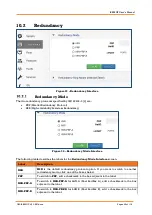
iRBX6GF User’s Manual
UM-iRBX6GF-4.5.1-EN.docx
Pages 108 of 119
LLDP
HSR supports LLDP (Link Layer Discovery Protocol) which provides an efficient Layer2 neighbor
discovery mechanism. It allows devices to advertise information about them to peer devices on the same
LAN and to learn information about peer devices.
LLDP information is sent by devices from each of their interfaces at a fixed interval, in the form of an
Ethernet frame. Each frame contains one LLDP Data Unit (LLDPDU). Each LLDPDU starts with the following
mandatory type-length-value (TLV) s:
Chassis ID
,
Port ID
, and
Time-to-Live (TLV)
. The mandatory TLVs
are followed by any number of optional TLVs. The frame ends with a special TLV, named
end of LLDPDU
in which both the
type
and
length
fields are 0.
To see the LLDP configuration, Global statistics, and LLDP mandatory TLVs, use
On the status report, TTL is the length of time (in seconds) for which an LLDP neighbor retains the
advertised data before discarding it.
LLDP-MED (
Media Endpoint Discovery)
, the LLDP (IEEE 802.1AB)[8] industry standard for supporting
advanced features on the network edge for Voice Over IP (VoIP) endpoint devices with specialized
capabilities and LLDP-MED standards-based functionality, is supported by default. By default, LLDP-MED
fast start mechanism is set to “yes” and LLDP-MED fast start interval=1.












































